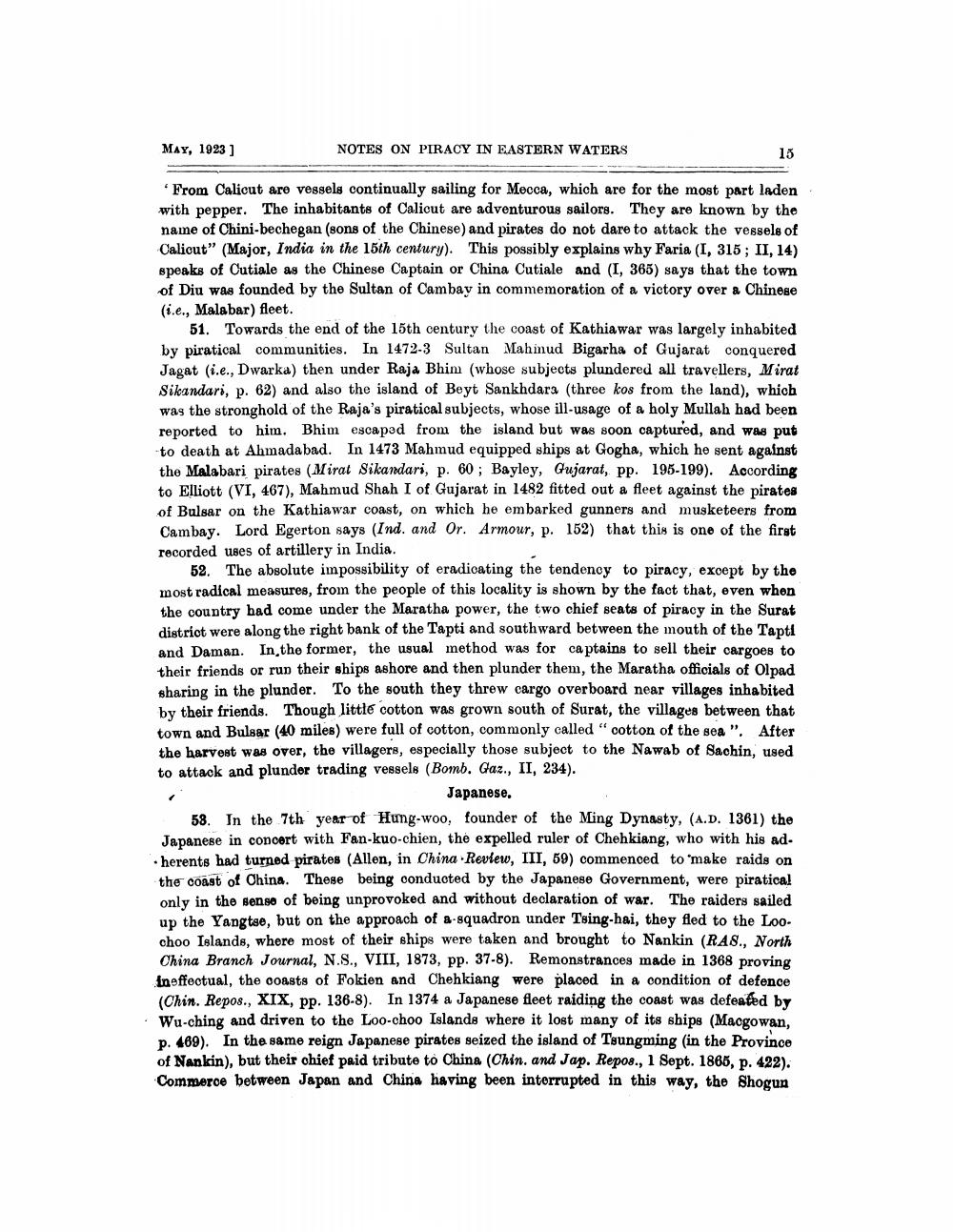________________
MAY, 1923 ]
NOTES ON PIRACY IN EASTERN WATERS
15
From Calicut are vessels continually sailing for Mecca, which are for the most part laden with pepper. The inhabitants of Calicut are adventurous sailors. They are known by the name of Chini-bechegan (sons of the Chinese) and pirates do not dare to attack the vessels of Calicut" (Major, India in the 15th century). This possibly explains why Faria (I, 315; II, 14) speaks of Cutiale as the Chinese Captain or China Cutiale and (I, 365) says that the town of Diu was founded by the Sultan of Cambay in commemoration of a victory over a Chinese (i.e., Malabar) fleet.
51. Towards the end of the 15th century the coast of Kathiawar was largely inhabited by piratical communities. In 1472-3 Sultan Mahinud Bigarha of Gujarat conquered Jagat (i.e., Dwarka) then under Raja Bhim (whose subjects plundered all travellers, Mirat Sikandari, p. 62) and also the island of Beyt Sankhdara (three kos from the land), which was the stronghold of the Raja's piratical subjects, whose ill-usage of a holy Mullah had been reported to him. Bhim escaped from the island but was soon captured, and was put to death at Ahmadabad. In 1473 Mahmud equipped ships at Gogha, which he sent against the Malabari pirates (Mirat Sikandari, p. 60; Bayley, Gujarat, pp. 195-199). According to Elliott (VI, 467), Mahmud Shah I of Gujarat in 1482 fitted out a fleet against the pirates of Bulsar on the Kathiawar coast, on which he embarked gunners and musketeers from Cambay. Lord Egerton says (Ind. and Or. Armour, p. 152) that this is one of the first recorded uses of artillery in India.
52. The absolute impossibility of eradicating the tendency to piracy, except by the most radical measures, from the people of this locality is shown by the fact that, even when the country had come under the Maratha power, the two chief seats of piracy in the Surat district were along the right bank of the Tapti and southward between the mouth of the Tapti and Daman. In the former, the usual method was for captains to sell their cargoes to their friends or run their ships ashore and then plunder them, the Maratha officials of Olpad sharing in the plunder. To the south they threw cargo overboard near villages inhabited by their friends. Though little cotton was grown south of Surat, the villages between that town and Bulsar (40 miles) were full of cotton, commonly called "cotton of the sea ". After the harvest was over, the villagers, especially those subject to the Nawab of Sachin, used to attack and plunder trading vessels (Bomb. Gaz., II, 234).
Japanese. 58. In the 7th year of Hung-woo, founder of the Ming Dynasty, (A.D. 1361) the Japanese in concert with Fan-kuo-chien, the expelled ruler of Chehkiang, who with his ad. herents had turned pirates (Allen, in China. Review, III, 59) commenced to 'make raids on the coast of China. These being conducted by the Japanese Government, were piratical only in the sense of being unprovoked and without declaration of war. The raiders sailed up the Yangtao, but on the approach of a-squadron under Tsing-hai, they fled to the Loochoo Islands, where most of their ships were taken and brought to Nankin (RA8., North China Branch Journal, N.S., VIII, 1873, pp. 37-8). Remonstrances made in 1368 proving Ineffectual, the coasts of Fokien and Chehkiang were placed in a condition of defence
(Chin. Repos., XIX, pp. 136-8). In 1374 a Japanese fleet raiding the coast was defeated by · Wu-ching and driven to the Loo-choo Islands where it lost many of its ships (Macgowan,
p. 469). In the same reign Japanese pirates seized the island of Tsungming (in the Province of Nankin), but their chief paid tribute to China (Chin, and Jap. Repos., 1 Sept. 1865, p. 422). Commerce between Japan and China having been interrupted in this way, the Shogun




